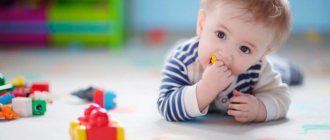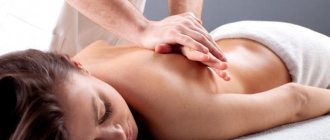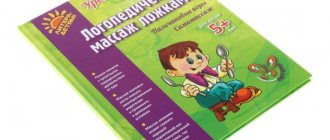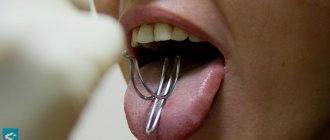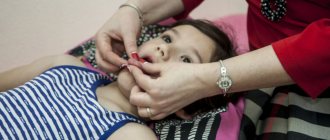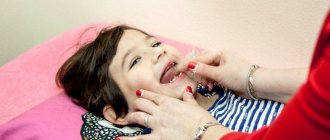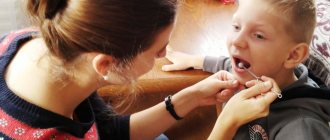The first sounds can be heard from babies at two months, and by the end of the first year of life, children can confidently pronounce syllables and whole words. However, it happens that kids lag behind their peers. The development of the speech apparatus is lame. To cope with this scourge, you should consult a doctor and regularly perform logomassage for children.
Even the most serious speech defects can be eliminated if you regularly perform speech therapy massage of the tongue.
Speech therapy tongue massage: what is it?
This term refers to a method of intense mechanical action on muscle and nerve fibers, blood vessels, which allows you to change the functional state of the speech organs.
This speech therapy technique is intended to normalize pronunciation and improve the mental state of patients with speech defects. Massage procedures are used for dysarthria - a pronunciation disorder caused by pathologies of the central nervous system, stuttering, and voice problems.
Target
Massage procedures have a positive effect on the body: they stimulate the secretory ability of the skin, improve the nutrition of the skin-muscle layers, normalize metabolism, lymph and blood circulation. The expansion of capillaries is noted, and oxygen exchange between blood and tissues improves. Special massage movements accelerate the inflow of arterial and outflow of venous blood, and increase the permeability of lymphatic vessels.
Under the influence of the procedures, muscle tissue changes significantly for the better: it becomes more elastic, strong, durable, contracts better, and regenerates faster after exercise. Through speech therapy massage, muscle spasms with excessive tone are weakened and, conversely, the tone of flaccid articulatory muscles is increased. Thanks to this, active movements of parts of the articulation system are carried out without difficulty.
Massage treatments have a positive effect on the body
Speech therapy massage at home has the following goals:
- restoration of muscle tone;
- stimulation of muscle fibers of the peripheral speech system that have weak contractility or do not contract at all;
- restoration of proprioception - the muscular sense of the position of body parts relative to each other and other objects;
- approaching the formation of voluntary movements of articulatory organs;
- getting rid of drooling;
- improvement of the pharyngeal reflex;
- stimulating pronunciation skills while inhibiting the formation of speech abilities.
In what cases is it recommended?
The indicator for choosing the type of speech therapy massage is the state of facial and articulatory motor skills. First, the speech therapist looks at the muscles when they are in a relaxed state. For this, it is best for the child to be in a lying position.
If the muscles have normal muscle tone, they will be slightly tense, and the skin will be soft and elastic. All manipulations do not cause discomfort. If the tone is increased, there is greater tension, manipulations are carried out with difficulty; if it is low, the muscles are in a sluggish and flabby state. For the first option, you need to do a massage for relaxation, and for hypotension, a stimulating one.
Also, the indication for this procedure is the presence of paresis and paralysis. In this case, one corner of the lips may be higher than the other or the jaw may be shifted to the side. But the specialist begins to work from the most preserved areas. The affected areas must be treated carefully to minimize possible discomfort.
To determine the condition of the facial and articulatory muscles, examine:
- condition of facial muscles and skin;
- state of articulatory motor skills;
- condition of the soft palate;
- pronunciation side of speech.
Based on the diagnostic results, the speech therapist decides whether the child needs a course of speech therapy massage and what techniques he will use in his work.
Types of speech therapy massage
It is better to entrust speech therapy massage to a professional who knows the physiology of the muscles responsible for speech activity.
Classic massage procedures include:
- therapeutic manual procedures - stroking, kneading, rubbing (with this option, speech therapists often use devices that increase the positive effect - pacifiers, brushes, etc.);
- point – local stimulation or relaxation of bioactive points in accordance with a specific disorder;
- hardware – impact on problem areas with vibration, vacuum and other special devices;
- probes - according to the methods of speech therapist Elena Viktorovna Novikova.
Self-administered procedures include:
- relaxation and stimulation of articulatory muscles;
- impact on the lingual muscles.
II. Types of massage
The field of speech therapy is so developed today that listing all the techniques would require writing a huge book. We will talk about the main techniques that are most often used in logotherapy.
Five main types of logomassage:
- classical;
- spot
- hardware;
- self-massage;
- probe
The classic to the usual manual facial massage - stroking, rubbing, kneading, etc.
To perform acupressure, you need to know the “active” points of the body, that is, this procedure requires special knowledge.
You can massage your body using a medical device - this will be a hardware massage .
Self-massage is performed by a child - for this he needs to be taught how to bite his tongue and massage his face correctly.
The probe allows you to reach remote parts of the articulation organs and thereby activate their work.
Massage can be aimed at relaxing or activating the speech organs. If you want to relax your muscles, try to press lightly, use sliding movements. If you decide to activate the muscles and add tone to them, massage deeply and energetically.
For various types of logomassage, spoons, toothbrushes, spatulas and probes are used.
Contraindications
Speech therapy tongue massage should not be performed at home if a young patient:
- acute form of any infectious disease (due to the child’s poor health, the procedure will be useless and painful);
- skin pathologies (possible painful sensations during massage movements);
- conjunctivitis;
- stomatitis;
- gingivitis;
- herpetic skin lesions;
- enlarged lymph nodes;
- increased contraction of the carotid artery.
Contraindicated for whom
Massage is contraindicated for the following diseases:
- acute inflammatory processes in the oral cavity: viral diseases (herpes), rash caused by bacterial infection, gingivitis, etc.;
- enlargement of the submandibular lymph nodes;
- acute infectious disease;
- high body temperature;
- symptomatic epilepsy;
- intracranial hypertension.
Also, speech therapy massage is impossible in cases where the child, due to age or mental state, is unable to listen to the doctor, has a negative attitude towards his actions, and cannot sit still.
Indications
Massage helps to cope with many problems of pronunciation formation
Feedback from many parents confirms that speech therapy massage for children at home is highly effective and helps to cope with many problems of pronunciation formation. Procedures are prescribed in the presence of specific pathologies:
- voice disorders that have a physiological or psychological origin (weakening of the voice, sore throat, rapid fatigue when speaking, discomfort during pronunciation, lump in the throat);
- dysarthria – pronunciation problems due to neurological pathologies;
- stuttering is a violation of sound pronunciation, in which certain sounds, syllables, or words are drawn out or repeated at a rapid pace;
- drooling;
- weak or high tone of articulatory muscles.
Massage procedures are also carried out to speed up the results of the speech therapist’s work, when a small patient should soon go to school, and the parents turned to a specialist for help late.
Correction of dysarthria with massage
The system for eliminating dysarthria includes lessons with a speech therapist on sound production, vocabulary development, breathing training, articulation stimulation, and exercises for fine motor skills. Massage of the tongue and face for dysarthria is used to activate the muscles of the speech apparatus. Kneading the muscles has a beneficial effect on the general nervous well-being of children with such a lesion and improves articulation skills.
During the massage process in children with dysarthria, the following changes occur:
- The number and strength of articulatory muscle spasms decreases;
- Speech quality improves;
- Muscle tone is normalized;
- Blood circulation in the brain and tissues is normalized;
- Children become less excitable and sleep better.
On a note! Logomassage is recommended for children not only with dysarthria, but also for stuttering, rhinolalia, and voice disorders.
Only a doctor or speech therapist-defectologist can prescribe speech therapy massage for children with dysarthria after diagnosing the disease.
Staticity and difficulties in the mobility of the lips, palate, and tongue are noticeable in some babies from birth. Parents should sound the alarm if the newborn has difficulties with sucking, swallowing food, speech after 2 years is slurred, and there is a nasal tone. Depending on the symptoms of the defect and the location of brain lesions, the following types of dysarthria are distinguished:
- Bulbarnaya. The most severe degree of the disease. Facial and articulatory muscles are affected.
- Pseudobulbar. Speech is slurred, monotonous, paralysis of the muscles of the speech apparatus is diagnosed.
- Cortical. The brain is damaged on one side. The child pronounces sounds well, but not syllables.
- Subcortical. Speech is slurred, nasal. The subcortical nodes of the brain are affected.
- Extrapyramidal. A preschooler has paralysis of the facial muscles.
- Erased. It is difficult for a child to pronounce hissing and whistling sounds.
The type of central nervous system damage and paralysis can be differentiated using MRI, EEG, clinical and speech therapy examination. A course of logomassage is prescribed for infants with a severe form of the disease from 3 months, for preschool children - in combination with therapeutic and pedagogical correction of disorders.
Speech therapy massage for increased tone
A patient with increased muscle tone is placed either on a horizontal surface or in a chair with a comfortable backrest. Slowly carry out light movements, repeating from 8 to 12 times.
- Start from the neck. Calmly rotate your head clockwise and back, to the left and to the right. Lightly massage the neck skin without pressure. This is how the tongue relaxes.
- Next they move on to the face. Smooth the forehead, eyelids, cheekbones, chin. Move your fingers from the neck to the collarbones. Finally, massage the jaw area, earlobes, and the area from the temples to the jaws.
- To relax the labial muscles, lightly stroke first the upper, then the lower lip from top to bottom and back, from the corners to the central part and back. Move your fingers from the nostrils to the corners of the mouth, lightly pressing on the lips.
- To relieve hypertonicity of the lingual muscles, the organ is easily rocked from left to right and back, from top to bottom and back. Use your fingers to stroke from the edges to the center, shake, pat, and pull in different directions.
Alternatives to logomassage
Speech therapist services are not that expensive. But parents whose child does not show positive results begin to look for alternatives to the procedure.
One option is neurofeedback or bioacoustic correction.
During the procedure, sensors are attached to a person's scalp to record brain wave activity. The doctor will be able to record the graph of brain activity during communication. The child is then fitted with headphones through which the “voiced” brain signals can be heard. This treatment is prescribed to children with severe speech delays.
Music therapy is more suitable for young patients without mental retardation. The baby is encouraged to listen to rhythmic songs and sing along to them.
With decreased tone
The patient is seated in the same way as in the case described above. The number of repetitions of movements is similar. The greatest attention is paid to the area of the cheekbones and jaws. They press harder on problem areas than when correcting increased tone, but not sharply, so as not to cause pain.
First, massage the forehead with horizontal stroking movements, then move on to the eyelids. Move your fingers from the nose to the ears, from the chin to the ears. They rub and pinch the skin on the cheekbones, knead the lips, areas from the nostrils to the corners of the mouth.
The final stage is the use of a vibration device to increase the tone of the lingual muscles.
Conditions for massage
It’s good if you have the opportunity to take your child to see a speech therapist. If this is not possible, then parents can learn how to do speech therapy massage for their child at home.
Procedures should be carried out in a quiet and calm environment. It is necessary to remove objects that may distract the small patient. The room should be ventilated. The massage therapist should wash their hands with warm water.
The first procedure lasts no more than 5 minutes, its main goal is patient adaptation. The first week the duration of classes is 10 minutes, the following procedures are carried out for 20–30 minutes. When setting the time frame, the age of the patient must be taken into account. Infants last no longer than 10 minutes, preschoolers - up to 20 minutes, schoolchildren - up to 30 minutes.
Classes are held 2-3 times a week. Daily procedures are not recommended, as they lead to muscle fatigue. The full course includes 15 lessons.
Description of the author's massage technique by Novikova E.V.
This version of speech therapy massage is often used in classes with children with dysarthria and alalia. To conduct it, you need to complete special courses. The massage is performed using a probe set, which includes:
- “fork” probe - it is used for light tingling, oscillatory and rotational movements;
- figure-of-eight probe - needed for pressing movements;
- “sleigh” probes (there are 3 of them in the set) – also for pressing movements;
- “hatchet” probe – necessary for pressing and sliding actions;
- “push” probe - it is used to apply pressing movements for several seconds, after which the muscles of the tongue begin to relax.
Probe massage is contraindicated for children under 6 months.
The duration of the course is 2-3 weeks, each exercise is performed up to 30 times. It is recommended again after 2 months. But it happens that one course of this logomassage is enough for children. Parents and speech therapists need to carefully monitor the child’s reaction: there is a category of children who do not like the touch of metal instruments. In this case, it will be more effective and correct to use other massage devices.
Technique
Massaging usually begins with the face, this way the general tension of the body is relieved. They begin to stroke the forehead, slowly moving down to the chin. Move your fingers gently, horizontally from the central part of the face to the edges: from the center of the forehead to the temples, from the eyebrows to the top of the ears, from the eyelids to the auricles, from the cheekbones to the earlobes. Repeat 2-3 times.
Next, move on to the main massage complex. Below are step-by-step procedures for each part of the articulatory apparatus.
Speech therapy tongue massage
Movements are performed from the edge of the organ to the root part.
- They wrap their fingers around the tip, move it up and down, left and right, push it inwards and pull it out of the mouth.
- Supporting the organ from below, stroke it with your thumb from the center to the edges and in a circular motion.
- They clasp the organ with the thumb and forefinger and stroke its upper and lower surfaces.
- Perform vibration movements: rock the organ, lightly tap it with a finger.
- Massage the frenulum by moving your finger up and down.
- Smooth the surface of the organ with a cloth having a different texture.
- Using a toothbrush with soft bristles, different letters are drawn on the mucous surface.
If the patient has increased salivation, then place a clean paper napkin under the tongue and change it after it gets wet.
Lip massage
These procedures also include massaging the nasolabial areas and chin.
Speech therapy massage should bring only positive emotions to the baby
- He rubs his lips with his fingers.
- Making circular movements with your finger, move from the right corner of the mouth to the left and back.
- The upper lip is massaged to the right, the lower lip to the left, then the direction of movement is changed.
- They sting the lips and skin around the mouth.
- They put pressure on the lips.
- They make gentle blows with their fingers.
Hand massage
Massage the fingers and palm separately. Each finger is worked from the outer phalanx to the base. The first one is the little finger.
- Press on the pads with increasing pressure.
- They work on the palm using the rhyme “The Magpie is White-sided.”
- Draw a spiral on your palm with your finger.
- A spiked rubber su-jok ball is passed over the palm of the hand.
- Dip your fingers into a container with different grains.
IV. How to massage?
Next, we’ll talk about how to massage a child’s face, use spoons, and perform articulation and finger massage to develop speech.
Logomassage of the face
Follow these instructions, unless otherwise directed by your doctor: when performing a massage, move from top to bottom, try not to strain. Don't forget that your hands are real medicine!
Logomassage with spoons
Spoons allow you to have a good effect on speech areas. Be sure to make sure the spoons have a smooth surface! Any small hangnails can injure a child’s skin! It is enough to repeat all movements 7-8 times.
Articulation massage for speech development
This type of massage requires the use of a spatula or toothbrush. In principle, it can be done by hand. Don't forget to wear medical gloves! Place a sterile cloth nearby to remove saliva. If the child feels pain, stop the session.
Before starting the procedure, it will be useful to relax the child: to do this, massage the collar area, neck muscles and jaws.
Finger logomassage for speech development
Massaging your fingers is the easiest way. There is no need for any serious knowledge or precautions here. All caring mothers and fathers do this. This massage is most useful for children who have not yet turned one year old.
The fact is that the nerve endings of the hands are considered to be connected to the speech areas in our brain. Therefore, finger massage can improve the baby’s speech. To enhance the effect, you can use a rubber ball.
All the procedures described really make it possible to correct sound pronunciation, form correct speech breathing, strengthen the voice and stabilize the emotional state. Therefore, we recommend that you perform different types of procedures to speed up speech correction.
Read our article for more details on how to learn to speak beautifully and competently as an adult >>>
Sets of tools for logomassage
Logomassage probes are special instruments made of wire. They are used to mechanically influence the tongue and other organs of the child’s articulatory apparatus. Their use allows you to introduce sounds to your baby and correct speech pronunciation. Probes are an exclusively domestic invention. In the EU and USA, speech therapists do not use probes - they do not even know the technology for handling them!
For the first time, the use of special tools for speech correction was invented by the Russian speech therapist, professor and teacher of the deaf, Fedor Andreevich Rau. He also developed the first forms of probes that are used by speech therapists to this day.
It is customary to divide instruments for logomassage into staged and massage. Staged ones are used for Rau and Volkova therapy, as well as for intermediate techniques.
Massage probes are used in the Novikova technique.
Probes are most often made of steel and wire. In stores you can buy sets of probes for performing different logomassage techniques. Typically, such kits contain from seven to 12 instruments. The sets cost between 2-3 thousand rubles. The following tools may also be useful to perform the procedure:
- massage stick;
- tongue raising device;
- mirror (for examining the mouth);
- wine cork (for articulation gymnastics);
- mouth dilators.
Speech therapy massage with spoons
Speech therapy massage is carried out with two spoons. The size of cutlery is determined by the age of the patient. Small plastic utensils are optimal for babies.
- The convex surface of the devices is stroked on the lips.
- Make circular movements on the lips.
- The edge of the spoon presses lightly on the nasolabial folds.
- They scrape the edges across the lips.
- The convex surface is used to massage the cheekbones and chin in a circular motion.
- Then the eyelids and the area under the eyes.
- Rub the bridge of the nose.
Massage with a toothbrush
Such procedures are carried out in case of weakening or loss of voice, drooling, or stuttering. They help strengthen articulatory muscles and eliminate speech disorders.
Massage procedures are best done before meals.
The initial speech therapy massage for children at home with a toothbrush lasts 5 minutes, for infants - 2. The time of the procedures is gradually increased, after a week the session should already take about 20 minutes. The procedure is completed earlier if discomfort occurs in the oral cavity.
Take a hygienic device with soft bristles. Place gauze or a paper napkin under the tongue to absorb saliva. Make circular and longitudinal movements without pressing on the mucous surface of the organ.
It is important not only to carry out, but also to complete massage procedures correctly. After classes, the little patient is praised for his patient and obedient behavior. This way he won’t have any whims before the next procedures.
Self-massage
Before self-massage, the child is shown all the basic techniques that will be used during the session. In the first lessons, the adult performs this procedure for the child himself, while verbalizing his actions. He then takes the child's hands and guides him.
Then the adult shows what needs to be done, and the child repeats after him. And when he masters the massage algorithm, he will be able to perform it, focusing only on the verbal instructions of an adult.
But if the child has a severe speech disorder, then it is better to do a probe massage. There are types of massage for children who have not only speech difficulties, but also other pathologies. For example, massage according to the method of A. F. Arkhipova, intended for children with cerebral palsy. It is aimed not only at improving articulatory and facial motor skills, but also takes into account the psychophysiological characteristics of such children.
Some believe that it is enough to undergo a course of speech therapy massage and the child’s sound pronunciation will immediately improve. No, logomassage usually acts as a complement to articulation and breathing exercises (in difficult cases it is the main focus). Having normalized muscle tone, you need to master new articulatory movements with your child. Only then will it be possible to correct the sound pronunciation and consolidate the result achieved by the massage.

